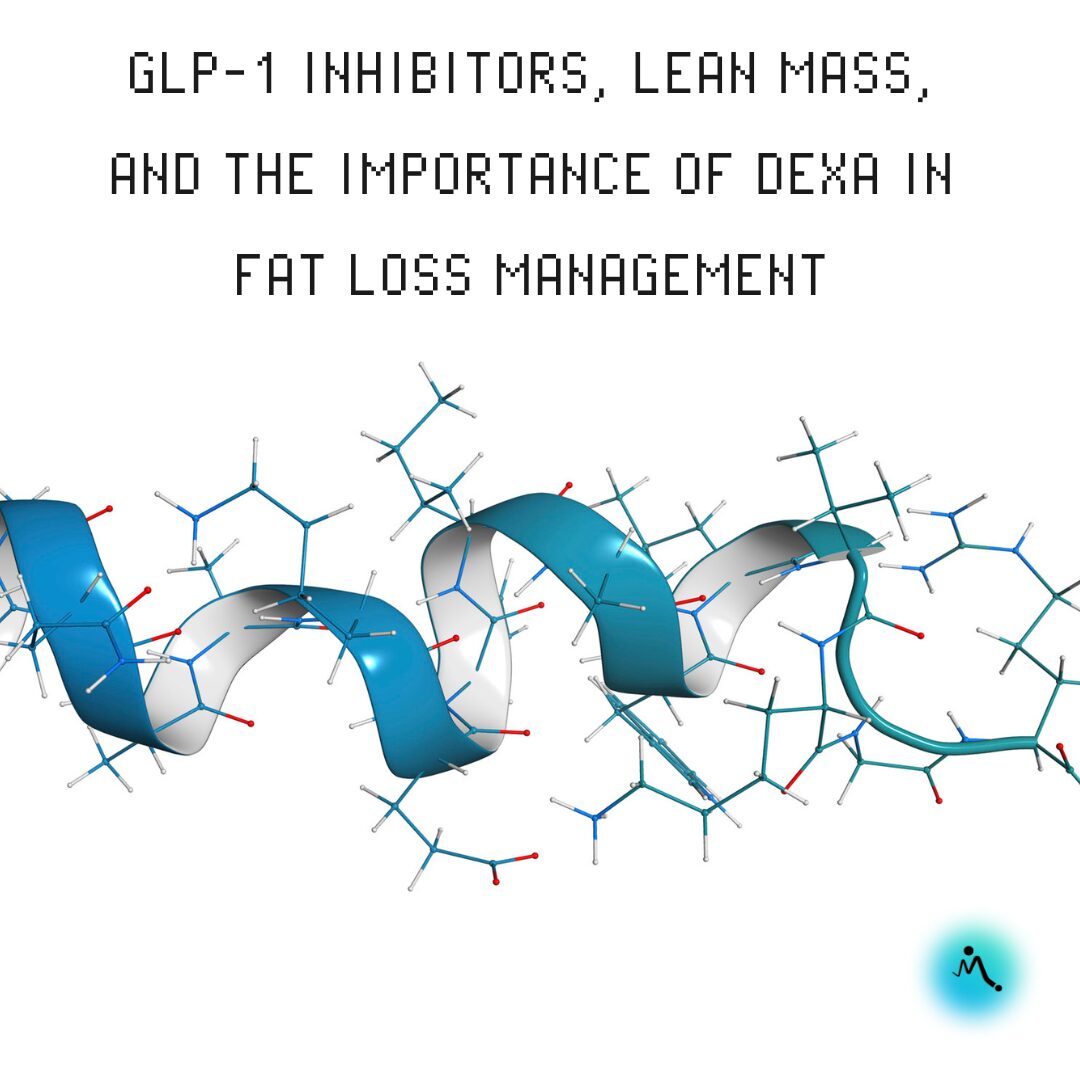GLP-1 receptor agonists have transformed the landscape of fat loss management, offering an effective solution for those struggling with obesity or fat-related health challenges. These medications, while effective for significant fat loss, raise an important concern: the potential loss of lean mass alongside fat mass. Preserving lean mass is essential for metabolic health, physical function, and long-term wellbeing, making it critical to monitor body composition during fat loss.
This issue is particularly relevant for men and women who are new to structured exercise and dietary changes. By incorporating Dual-Energy X-ray Absorptiometry (DEXA) scans into their journey, individuals can ensure they are optimising fat loss while preserving lean mass for sustainable health outcomes.
How GLP-1 Inhibitors Affect Body Composition
GLP-1 receptor agonists mimic the hormone glucagon-like peptide-1, which helps regulate appetite and glucose metabolism. By reducing appetite and promoting feelings of fullness, they enable significant reductions in calorie intake and fat loss. However, studies show that this fat loss often includes a combination of fat mass and lean mass, with lean mass accounting for as much as 30% of the total fat lost in some individuals¹.
Lean mass, which includes muscle tissue, connective tissue, and organ mass, is vital for maintaining metabolism, strength, and overall physical health. Losing lean mass can slow metabolic rate, reduce functional strength, and increase the risk of regaining fat². Addressing this issue is crucial for anyone undergoing fat loss, especially those on GLP-1 receptor agonists.
The Role of Lean Mass in Health
Lean mass is important for both men and women, contributing to strength, energy, and long-term health. For men, lean mass is directly linked to metabolic rate, physical performance, and hormonal health³. For women, it plays a critical role in maintaining bone density, metabolic stability, and functional independence, especially as they age⁴.
Preserving lean mass during fat loss not only supports physical function but also helps maintain a healthy metabolism, ensuring fat loss is sustainable. This is particularly important for individuals new to exercise or who may not prioritise strength training and protein intake.
Why DEXA is the Gold Standard for Monitoring Body Composition
Tracking changes in body composition is essential to ensure fat loss is primarily from fat mass, not lean mass. While several methods exist to measure body composition, DEXA stands out as the most accurate and reliable option⁵.
DEXA scans provide a detailed breakdown of fat mass, lean mass, and bone density, offering a comprehensive view of body composition⁶. Unlike a standard scale, which only shows total body weight, DEXA allows individuals to monitor the quality of their fat loss and make informed adjustments to their exercise and nutrition strategies.
The Limitations of Bioelectrical Impedance
Many people turn to bioelectrical impedance analysis (BIA) devices, such as handheld devices or smart scales, to measure body composition. While these tools are accessible and affordable, they often lack the precision needed for meaningful insights. BIA works by sending a small electrical current through the body and measuring resistance to estimate body composition. However, its accuracy is highly variable and can be influenced by factors such as:
- Hydration levels: Dehydration or fluid retention can skew results, leading to inaccurate readings of lean and fat mass⁷.
- Recent exercise or meals: These can temporarily alter the body’s water content, further impacting measurements⁸.
- Device quality: Consumer-grade devices often lack the sophistication required for reliable data⁹.
Compared to BIA, DEXA is far superior in accuracy and consistency. It is not affected by hydration status or other temporary variables, making it the most reliable method for monitoring changes in lean mass and fat mass over time¹⁰.
Strategies for Preserving Lean Mass During Fat Loss
Preserving lean mass requires a deliberate combination of exercise, nutrition, and regular monitoring. Here are some key strategies:
- Strength Training
Incorporating strength training is the most effective way to maintain and build muscle. Resistance exercises, such as weightlifting, resistance band training, or bodyweight exercises, should be performed at least two to three times per week¹¹. For beginners, starting with lighter resistance and focusing on proper form can ensure safe and effective muscle engagement.
- Adequate Protein Intake
Protein is essential for muscle repair and maintenance. Individuals should aim for 1.2–2.0 grams of protein per kilogram of body weight per day, depending on activity levels and goals¹². Incorporating protein-rich foods, such as lean meats, fish, eggs, dairy, tofu, legumes, and protein supplements, can help meet these targets.
- Regular DEXA Monitoring
A DEXA scan every 3–6 months provides precise data on changes in lean mass, fat mass, and bone density¹³. This enables individuals to track their progress and adjust their approach as needed, ensuring lean mass preservation while continuing to lose fat.
- Progressive Overload in Training
Gradually increasing the intensity of strength training exercises, whether through added weight, increased repetitions, or advanced movements, stimulates muscle growth and adaptation¹⁴. This prevents plateaus and enhances lean mass preservation.
- Professional Guidance
Engaging with a dietitian, exercise physiologist, or personal trainer experienced in body composition management can provide tailored advice and accountability, ensuring strategies align with individual goals.
Conclusion: A Balanced Path to Sustainable Fat Loss
GLP-1 receptor agonists provide an effective avenue for fat loss, but they are not a standalone solution. Preserving lean mass is critical for achieving sustainable, long-term results. DEXA scans, as the gold standard for body composition analysis, offer an invaluable tool to track progress and make informed adjustments. Compared to bioelectrical impedance, DEXA provides unmatched accuracy and reliability, ensuring that individuals can optimise fat loss while protecting their metabolic and physical health.
For both men and women, combining GLP-1 receptor agonists with strength training, proper nutrition, and regular DEXA monitoring creates a balanced and effective strategy. By focusing on lean mass preservation, individuals can achieve their fat loss goals while building a foundation for a healthier, stronger future.
References
- Wilding, J. P. H., et al. (2021). Obesity and Lean Mass in GLP-1 Receptor Agonist Therapy. Diabetes, Obesity and Metabolism.
- DeLany, J. P., et al. (2022). Lean Mass Dynamics During Fat Loss. Journal of Clinical Endocrinology & Metabolism.
- Wang, Z., et al. (2020). Muscle Mass and Metabolic Rate: Implications for Health. American Journal of Physiology.
- Salvatore, G., et al. (2023). Bone Density and Lean Mass in Women’s Health. Journal of Bone and Mineral Research.
- Heymsfield, S. B., et al. (2018). DEXA vs. Other Methods for Body Composition Analysis. Obesity Reviews.
- Silva, A. M., et al. (2020). Comparative Accuracy of DEXA and BIA. Clinical Nutrition.
- Kyle, U. G., et al. (2004). BIA Accuracy and Limitations in Clinical Use. Nutrition Journal.
- Thomas, D. M., et al. (2013). Hydration Effects on Body Composition Estimates. European Journal of Clinical Nutrition.
- Bosy-Westphal, A., et al. (2013). Consumer Bioimpedance Devices: A Critical Review. Nutrition & Metabolism.
- Fuller, N. J., et al. (1992). Validation of DEXA for Lean Mass Assessment. Clinical Science.
- Phillips, S. M., et al. (2017). Exercise Interventions for Muscle Preservation During Fat Loss. Sports Medicine.
- Pasiakos, S. M., et al. (2015). Protein Recommendations for Body Composition Changes. American Journal of Clinical Nutrition.
- Forbes, G. B. (2000). DEXA as a Tool for Monitoring Fat Loss. International Journal of Obesity.
- Schoenfeld, B. J., et al. (2019). Progressive Overload in Resistance Training. Journal of Strength and Conditioning Research.


